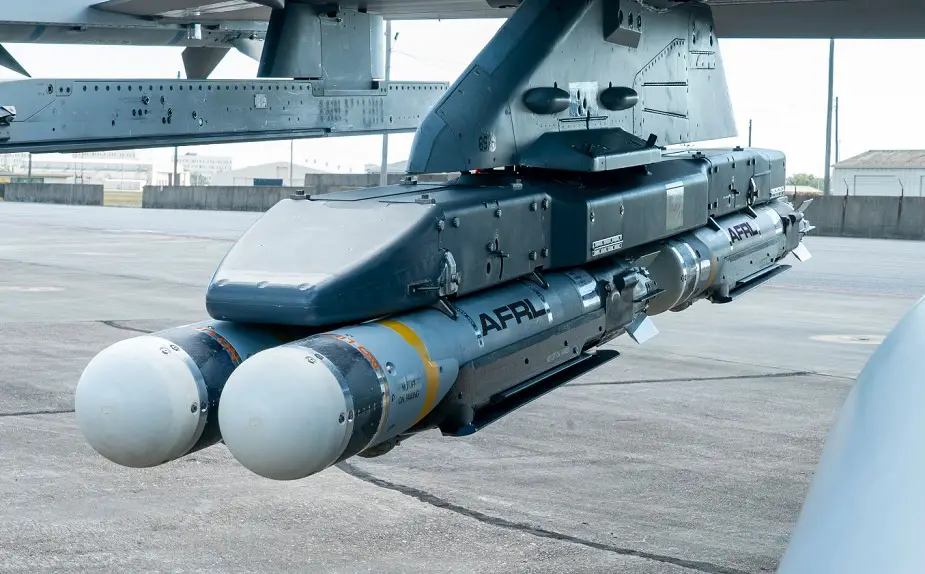Breaking news
AFRL demonstrates first collaborative weapon technologies.
The Air Force Golden Horde Vanguard program completed the first Air Force flight demonstration of collaborative weapons Dec. 15 using technology developed by the Air Force Research Laboratory and Scientific Applications & Research Associates.
Follow Air Recognition on Google News at this link
 Four Collaborative Small Diameter Bombs, or CSDBs, hang from the wing of an F-16 Fighting Falcon from the Air Force Test Center’s 96th Test Wing at Eglin Air Force Base, Fla., Nov. 14, 2020. Two of the bombs were dropped during the first flight demonstration of the Air Force Golden Horde Vanguard program. (Picture source: U.S. Air Force)
Four Collaborative Small Diameter Bombs, or CSDBs, hang from the wing of an F-16 Fighting Falcon from the Air Force Test Center’s 96th Test Wing at Eglin Air Force Base, Fla., Nov. 14, 2020. Two of the bombs were dropped during the first flight demonstration of the Air Force Golden Horde Vanguard program. (Picture source: U.S. Air Force)
A team from the Air Force Test Center flew an F-16 Fighting Falcon and released two Collaborative Small Diameter Bombs, which are Small Diameter Bombs that have been modified with a collaborative autonomy payload. The CSDBs quickly established communication with each other and their seekers detected a GPS jammer.
During the mission, the weapons referred to predefined rules of engagement, a set of constraints preloaded by a mission planner, and determined that the jammer was not the highest priority target. The weapons then collaborated to identify the two highest priority targets. However, due to an improper weapon software load, the collaboration guidance commands were not sent to the weapon navigation system. Without the updated target locations, the weapons impacted a failsafe target location.
“The Golden Horde demonstration with the Small Diameter Bomb flights is an important step on the path to Networked Collaborative Weapon systems. Completion of this first mission sets the stage for further development and transition to the warfighter,” said Chris Ristich, AFRL Transformational Capabilities Office director.
This initial demonstration represents a critical first step for the Golden Horde program, an initiative focused on advancing networked, collaborative and autonomous, or NCA, weapon capabilities through live and virtual testing. These new technology areas provide the Air Force with a revolutionary way to engage adversary targets.
NCA weapons observe and react to a dynamic battlespace in real time, thereby increasing mission effectiveness within the enemy’s decision loop. When deployed in mass, NCA weapons effectively share information and collaborate to overwhelm adversary defenses.
The technologies enabling this new capability include a home-on-GPS-jam seeker that gathers information about the battlespace, a software defined radio for communication between weapons and a processor preloaded with collaborative algorithms.
The collaborative algorithms use a dynamic approach called play calling, similar to a quarterback calling a play in football. A “play” is an established behavior that groups of collaborative weapons, or swarms, can enable or disable when they meet certain predefined conditions. Weapons that use this technology are semi-autonomous since they abide by predefined rules of engagement and only execute based on an approved list of plays.
While this demonstration has given the Air Force insight and confidence in networked, collaborative and autonomous weapons technologies, no intention currently exists to transition this technology to the CSDB. Col. Garry Haase, director of the AFRL Munitions Directorate explained, “This successful Golden Horde demonstration builds the foundation for integrating this technology into a variety of other weapon systems, which will help the U.S. maintain a technological advantage over our adversaries.”
“I’m very pleased with the results of this first test,” stated Steven Stockbridge, Golden Horde principal investigator. “The team saw good performance from the networked collaborative sub-systems and understood the root cause of the weapons not impacting the desired targets. We anticipate readiness for the next flight test.” Two more CSDB flight tests are planned for early 2021, increasing the number of collaborative weapons in each demonstration to four.



















